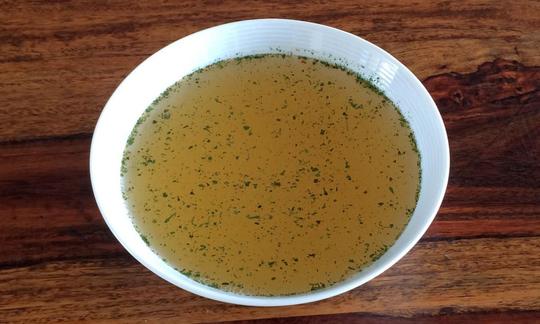Vegan Broth
vegan
Ingredients (for servings, )
| For the soup base | |
|---|---|
| 1 | Onions, raw (organic?) (3.9 oz) |
| 8 ½ oz | Celeriac, raw (organic?) |
| 2 stalks, cleaned | Leek, raw (organic?) (6.3 oz) |
| 3 | Celery (bleached celery), raw (organic?) (53 oz) |
| 4 | Carrots (carrots), raw (organic?) (8.6 oz) |
| 1 tbsp | Rapeseed oil (canola, HOLL oil, kernel oil), cold pressed?, organic? (0.49 oz) |
| Seasoning and storing | |
| 1 bunch | Parsley, fresh, raw (leaf parsley, parsley) (1.1 oz) |
| 2 cloves | Garlic (organic?) (0.21 oz) |
| 2 leaves | Bay laurel (raw? organic?) (0.01 oz) |
| 8 corns | Black pepper (organic?, raw?) (0.01 oz) |
| 1 dash | Table salt (table salt, raw?, organic?) (0.01 oz) |
| 3 liter | Drinking water, raw (organic?) (105 oz) |
Equipment
- vegetable peeler
- stove
- saucepan
Type of preparation
- cook
- strain
- can (bottle)
- sauté
- remove the skin
- peel
Preparation
For the soup base
Peel the onion and celery root. Clean the leeks, cut in half lengthwise, and then rinse. Clean the celery stalks (including the green tops) and the carrots. Chop coarsely.Heat the canola oil in a large saucepan. Sauté all of the ingredients on medium heat for about 5 minutes. The ingredients should take on a little color but not cook for too long.
Seasoning and storing
Wash the parsley and then add to the saucepan along with the unpeeled garlic cloves, the bay leaves, and the salt and pepper. Pour the water on top and then bring everything to a boil.Reduce the heat to low and let the broth simmer for 1½ hours.
Pour the vegetable broth through a sieve into a second saucepan, carefully pressing the water out of the vegetables. Let the broth cool.
Depending on the temperature used to prepare the broth, the recipe to serve 8 will yield between 2 and 2.5 liters. Covered, the vegan broth can be stored in the refrigerator for several days. And in a sealed freezing bag, it can be frozen and stored even longer.
|
Nutritional Information per person
Convert per 100g
|
2000 kcal | |
|---|---|---|
| Energy | 93 kcal | 4.6% |
| Fat/Lipids | 2.4 g | 3.4% |
| Saturated Fats | 0.26 g | 1.3% |
| Carbohydrates (inc.dietary fiber) | 16 g | 6.1% |
| Sugars | 5.9 g | 6.6% |
| Fiber | 5.2 g | 20.8% |
| Protein/Albumin | 2.7 g | 5.4% |
| Cooking Salt (Na:243.9 mg) | 620 mg | 25.8% |
| Essential micronutrients with the highest proportions | per person | 2000 kcal | |
|---|---|---|---|
| Vit | Vitamin K | 101 µg | 134.0% |
| Vit | Folate, as the active form of folic acid (née vitamin B9 and | 98 µg | 49.0% |
| Vit | Vitamin A, as RAE | 341 µg | 43.0% |
| Elem | Potassium, K | 763 mg | 38.0% |
| Sodium, Na | 244 mg | 30.0% | |
| Vit | Vitamin C (ascorbic acid) | 19 mg | 24.0% |
| Min | Manganese, Mn | 0.44 mg | 22.0% |
| Vit | Vitamin B6 (pyridoxine) | 0.31 mg | 22.0% |
| Min | Copper, Cu | 0.18 mg | 18.0% |
| Elem | Calcium, Ca | 133 mg | 17.0% |
Detailed Nutritional Information per Person for this Recipe
The majority of the nutritional information comes from the USDA (US Department of Agriculture). This means that the information for natural products is often incomplete or only given within broader categories, whereas in most cases products made from these have more complete information displayed.
If we take flaxseed, for example, the important essential amino acid ALA (omega-3) is only included in an overarching category whereas for flaxseed oil ALA is listed specifically. In time, we will be able to change this, but it will require a lot of work. An “i” appears behind ingredients that have been adjusted and an explanation appears when you hover over this symbol.
For Erb Muesli, the original calculations resulted in 48 % of the daily requirement of ALA — but with the correction, we see that the muesli actually covers >100 % of the necessary recommendation for the omega-3 fatty acid ALA. Our goal is to eventually be able to compare the nutritional value of our recipes with those that are used in conventional western lifestyles.
| Essential fatty acids | per person | 2000 kcal |
|---|---|---|
| Alpha-Linolenic acid; ALA; 18:3 omega-3 | 0.18 g | 9.0% |
| Linoleic acid; LA; 18:2 omega-6 | 0.58 g | 6.0% |
| Essential amino acids | per person | 2000 kcal |
|---|---|---|
| Threonine (Thr, T) | 0.12 g | 13.0% |
| Tryptophan (Trp, W) | 0.03 g | 11.0% |
| Isoleucine (Ile, I) | 0.08 g | 7.0% |
| Lysine (Lys, K) | 0.11 g | 6.0% |
| Valine (Val, V) | 0.10 g | 6.0% |
| Leucine (Leu, L) | 0.13 g | 5.0% |
| Phenylalanine (Phe, F) | 0.08 g | 5.0% |
| Methionine (Met, M) | 0.02 g | 2.0% |
| Vitamins | per person | 2000 kcal |
|---|---|---|
| Vitamin K | 101 µg | 134.0% |
| Folate, as the active form of folic acid (née vitamin B9 and | 98 µg | 49.0% |
| Vitamin A, as RAE | 341 µg | 43.0% |
| Vitamin C (ascorbic acid) | 19 mg | 24.0% |
| Vitamin B6 (pyridoxine) | 0.31 mg | 22.0% |
| Pantothenic acid (vitamin B5) | 0.72 mg | 12.0% |
| Riboflavin (vitamin B2) | 0.16 mg | 11.0% |
| Vitamin E, as a-TEs | 1.4 mg | 11.0% |
| Thiamine (vitamin B1) | 0.10 mg | 9.0% |
| Niacin (née vitamin B3) | 1.3 mg | 8.0% |
| Biotin (ex vitamin B7, H) | 2.1 µg | 4.0% |
| Essential macroelements (macronutrients) | per person | 2000 kcal |
|---|---|---|
| Potassium, K | 763 mg | 38.0% |
| Sodium, Na | 244 mg | 30.0% |
| Calcium, Ca | 133 mg | 17.0% |
| Phosphorus, P | 107 mg | 15.0% |
| Magnesium, Mg | 44 mg | 12.0% |
| Essential trace elements (micronutrients) | per person | 2000 kcal |
|---|---|---|
| Manganese, Mn | 0.44 mg | 22.0% |
| Copper, Cu | 0.18 mg | 18.0% |
| Iron, Fe | 1.4 mg | 10.0% |
| Fluorine, F | 276 µg | 8.0% |
| Zinc, Zn | 0.56 mg | 6.0% |
| Selenium, Se | 1.4 µg | 3.0% |
| Iod, I (Jod, J) | 1.3 µg | 1.0% |
Vegan broth has a wide variety of uses. This recipe is easy to make and can be varied to suit your taste.
Definition of broth: In cooking, there are several differences between broth and stock. Broth can be used as an ingredient or served as a dish on its own whereas stock has been boiled down, concentrated, and isn’t salted and is therefore only used as an ingredient for other recipes.
Estimated yield and boiling down: Although it first seems that large amounts of fluid and ingredients are used for this recipe, a recipe to serve 8 people will in the end make about 2 to 2.5 liters. This amount depends, however, on the temperature the burner is set to, the time the soup is boiled down, and the size of the pot. If you only plan to use part of the stock immediately, it is an estimated yield that you can use to plan the number of containers you will need for canning.
Tips for storing: Sterilize the canning jars briefly in boiling water and then let dry upside down on a clean towel. Pour the hot vegetable broth into the dry jars, close tightly, and let stand upside down for 5 minutes. It is important that the jars are sterile, so make sure to avoid any contact with the inside of the jars or lid.
Less work with organic vegetables: If you use only organic vegetables to make the broth, you don’t have to peel them first. And this adds extra flavor to the broth.
Using vegetable scraps: Vegetable scraps can also be used to make broth and give it a stronger flavor.
Varying the ingredients: You can vary the vegetables and use your favorites and those that you have on hand. And you might like to add additional herbs and spices (e.g., oregano, thyme, or summer savory from the garden) or allspice berries and juniper berries.
Instant broth: To make instant broth, you can purée fresh vegetables in the blender, seasoning with salt, and then let dry. For this step, you have a variety of options. Either you can dry the vegetables in a dehydrator or you can spread the mixture out (layer should be about 1 cm thick) on a baking sheet lined with baking paper and then dry in the oven (at 60 °C for several hours or at 80 °C for 1–2 hours with additional drying on the fresh air). Then blend the dried mixture again until you have a fine powder.




